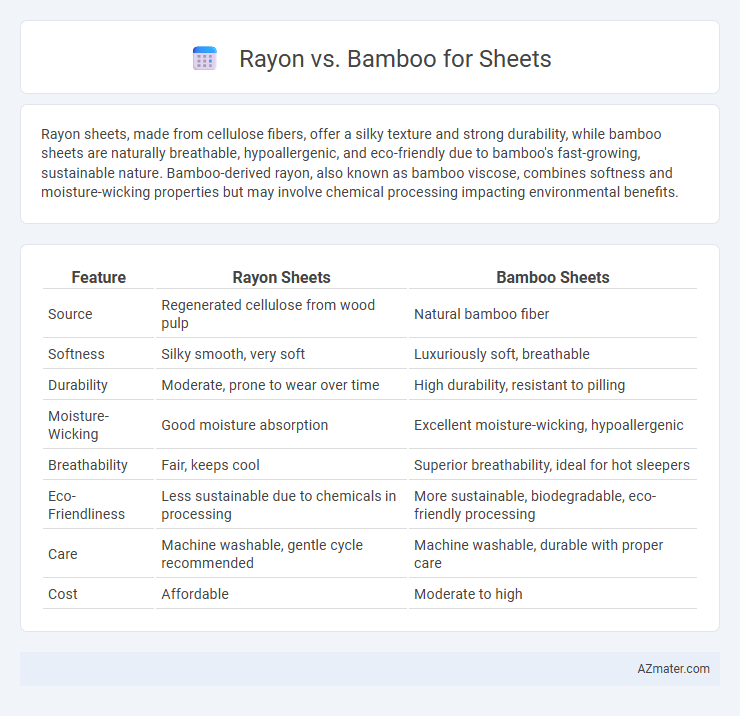Rayon sheets, made from cellulose fibers, offer a silky texture and strong durability, while bamboo sheets are naturally breathable, hypoallergenic, and eco-friendly due to bamboo's fast-growing, sustainable nature. Bamboo-derived rayon, also known as bamboo viscose, combines softness and moisture-wicking properties but may involve chemical processing impacting environmental benefits.
Table of Comparison
| Feature | Rayon Sheets | Bamboo Sheets |
|---|---|---|
| Source | Regenerated cellulose from wood pulp | Natural bamboo fiber |
| Softness | Silky smooth, very soft | Luxuriously soft, breathable |
| Durability | Moderate, prone to wear over time | High durability, resistant to pilling |
| Moisture-Wicking | Good moisture absorption | Excellent moisture-wicking, hypoallergenic |
| Breathability | Fair, keeps cool | Superior breathability, ideal for hot sleepers |
| Eco-Friendliness | Less sustainable due to chemicals in processing | More sustainable, biodegradable, eco-friendly processing |
| Care | Machine washable, gentle cycle recommended | Machine washable, durable with proper care |
| Cost | Affordable | Moderate to high |
Introduction to Rayon and Bamboo Sheets
Rayon sheets, made from regenerated cellulose fibers, offer a smooth, breathable, and moisture-wicking fabric ideal for sensitive skin. Bamboo sheets, derived from bamboo pulp processed into bamboo viscose or rayon, provide a naturally hypoallergenic, eco-friendly, and durable bedding option. Both materials excel in softness and temperature regulation, with bamboo sheets often favored for their sustainability and antimicrobial properties.
What is Rayon?
Rayon is a semi-synthetic fiber made from regenerated cellulose, typically derived from wood pulp, including bamboo. It offers a soft, breathable texture similar to natural fibers, making it popular for bedsheets and clothing. Bamboo rayon specifically refers to rayon produced from bamboo cellulose, combining bamboo's eco-friendly appeal with rayon's smoothness and durability.
What is Bamboo?
Bamboo fabric is derived from the cellulose fibers extracted from bamboo grass, making it a type of rayon known as bamboo rayon or bamboo viscose. This material is prized for its natural antibacterial properties, breathability, and moisture-wicking capabilities, which contribute to a cool and comfortable sleep experience. Unlike traditional rayon, which can be made from various wood pulps, bamboo rayon specifically utilizes the fast-growing bamboo plant, promoting sustainability and eco-friendliness in textile production.
Production Process: Rayon vs Bamboo
Rayon sheets are produced through a chemical-intensive process where cellulose from wood pulp undergoes treatment with caustic soda and carbon disulfide to create viscose fibers. Bamboo sheets, often labeled as bamboo rayon or bamboo viscose, utilize the same manufacturing method but start with bamboo cellulose, which requires substantial chemical processing to break down the tough bamboo fibers. Both materials involve energy and chemical use that impact environmental sustainability, with variations depending on the specific production facilities and regulations.
Environmental Impact Comparison
Rayon sheets, derived from chemically processed wood pulp, typically involve intensive use of water, energy, and toxic chemicals, contributing to environmental pollution and deforestation. Bamboo sheets, though marketed as eco-friendly, also undergo significant chemical treatments to convert bamboo fibers into viscose rayon, raising concerns about chemical waste and resource use. Choosing certified organic bamboo or lyocell options can reduce negative environmental impact by utilizing cleaner, closed-loop production processes with less harm to ecosystems.
Comfort and Softness Differences
Rayon and bamboo sheets differ significantly in comfort and softness, with bamboo sheets often praised for their exceptional breathability and moisture-wicking properties, which enhance overall comfort. Bamboo fibers naturally create a smooth, silky texture that feels soft against the skin, while rayon, derived from wood pulp, may offer a similar softness but can vary depending on the manufacturing process. Bamboo sheets also tend to be hypoallergenic and cooler, making them particularly comfortable for sensitive skin and warmer climates compared to standard rayon sheets.
Durability and Longevity
Rayon sheets, made from cellulose fibers derived from wood pulp, offer moderate durability but tend to weaken with frequent washing and prolonged use. Bamboo sheets, produced through a similar viscose process but from bamboo fibers, often exhibit enhanced longevity due to bamboo's natural antifungal and antibacterial properties that help maintain fabric integrity. Both materials require gentle care, yet bamboo sheets generally provide superior durability and sustained softness over time compared to standard rayon fabrics.
Breathability and Moisture Wicking
Rayon and bamboo fabrics both offer excellent breathability, allowing air to circulate and keeping the sleeper cool. Bamboo fibers naturally wick moisture away from the skin more efficiently than rayon, enhancing comfort by reducing sweat accumulation. Despite rayon's smooth texture, bamboo sheets excel in moisture management, making them ideal for hot and humid climates.
Care and Maintenance
Rayon sheets require gentle washing in cold water and air drying to prevent shrinkage and maintain softness, while bamboo sheets benefit from low-temperature machine washing and tumble drying on a gentle cycle to preserve their natural fibers and moisture-wicking properties. Avoid bleach and fabric softeners for both fabrics to extend their lifespan and retain fiber integrity. Carefully following care instructions ensures Rayon and bamboo sheets remain soft, durable, and comfortable over time.
Which is Better: Rayon or Bamboo Sheets?
Rayon and bamboo sheets both offer a soft, breathable fabric ideal for bedding, but rayon made from bamboo fibers often delivers enhanced moisture-wicking and hypoallergenic properties, making it a preferred choice for sensitive skin. Bamboo rayon sheets typically feature better durability and eco-friendliness due to sustainable bamboo harvesting and eco-conscious production methods compared to generic rayon. Consumers prioritize bamboo rayon sheets for their silky texture, antimicrobial benefits, and superior temperature regulation, providing a more comfortable and natural sleep experience.

Infographic: Rayon vs Bamboo for Sheet
 azmater.com
azmater.com